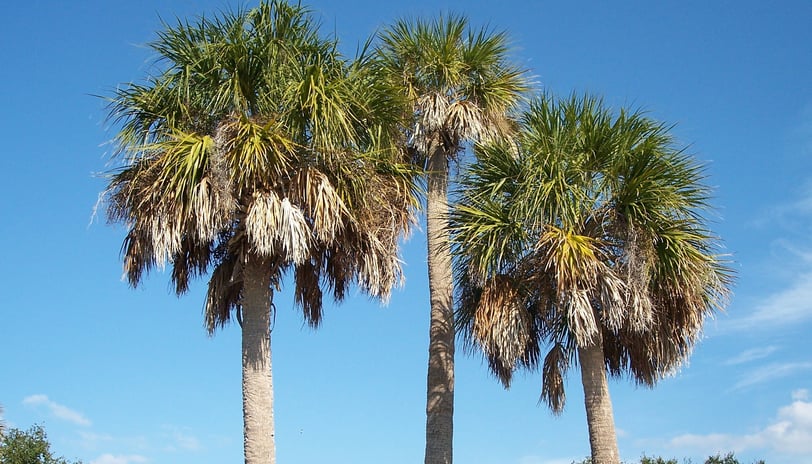Guide to Planting Cabbage Palms in Northern Florida
2/14/20253 min read


How to Properly Plant a Cabbage Palm in Northern Florida
Cabbage palms, or Sabal palmetto, are a staple in Florida landscapes, known for their iconic fan-shaped leaves and their resilience in the face of the state's variable climate. These palms thrive in a range of conditions but require proper planting and care to flourish. In Northern Florida, where winters can be colder than in the southern parts of the state, it’s especially important to plant cabbage palms correctly to ensure they withstand the climate. Here’s your step-by-step guide to planting a cabbage palm in Northern Florida.
1. Choosing the Right Location
Cabbage palms are quite versatile and can adapt to various soil types, but they do best in full sunlight. When selecting a spot for your palm, consider the following:
Full Sun: Cabbage palms thrive in direct sunlight, so choose a location that receives at least 6–8 hours of sunlight per day.
Soil Conditions: While these palms are tolerant of different soils, they prefer well-drained soil. Avoid areas where water tends to pool or where the soil stays soggy after rain.
Space: Make sure to plant your cabbage palm far enough from buildings, fences, or other trees. A space of 6 to 10 feet will give your palm room to grow and spread its leaves.
2. Timing Your Planting
The best time to plant a cabbage palm in Northern Florida is during the spring or early fall when temperatures are mild. This gives the palm time to establish its roots before the summer heat or winter cold sets in.
Spring Planting: Planting in the spring (March to early May) allows the palm to settle in and grow before the summer heat.
Fall Planting: Fall (September to early November) is also a good time as it avoids the extreme summer heat and allows the plant to establish roots before the cooler winter months.
3. Preparing the Planting Hole
Dig the Hole: Start by digging a hole that is twice as wide as the root ball of your cabbage palm, but only as deep as the root ball. This ensures the roots can spread out but prevents the palm from being planted too deep.
Soil Amendment: If your soil is heavy clay or sandy, amend it with organic compost to improve drainage and provide the palm with extra nutrients. Avoid using fertilizers at planting time to allow the roots to acclimate.
4. Planting the Cabbage Palm
Position the Palm: Place the palm in the hole, ensuring the top of the root ball is level with the surrounding soil. Do not plant it too deep, as this can suffocate the roots and cause the palm to rot.
Backfill: Fill in the hole with soil, gently packing it around the root ball to eliminate air pockets. Water the palm thoroughly after planting to help settle the soil.
5. Watering and Mulching
Watering: Cabbage palms are drought-tolerant once established but need regular watering during their first year of growth. Water deeply to encourage the roots to grow deeper into the soil. Avoid overwatering, as this can lead to root rot.
Mulching: Apply a 2- to 3-inch layer of mulch around the base of the palm to help retain moisture and regulate soil temperature. Keep the mulch a few inches away from the trunk to prevent rot.
6. Protecting the Palm from Winter Cold
While cabbage palms are cold-hardy, they can still be affected by frost or freezing temperatures in Northern Florida. Here are a few tips for protection during the colder months:
Covering: In case of a freeze warning, you can cover the palm with a frost cloth or burlap. Just make sure the cover does not touch the leaves to avoid damage.
Watering in Winter: Water your palm deeply before a cold snap to prevent dehydration, but avoid excess moisture around the roots.
Watch for Damage: If frost damage does occur, prune any brown or dead fronds after the risk of frost has passed.
7. Ongoing Care and Maintenance
Fertilizing: Cabbage palms do not require heavy fertilization, but applying a slow-release, palm-specific fertilizer in spring can promote healthy growth. Avoid over-fertilizing, as this can lead to excessive growth that stresses the tree.
Pruning: Trim any dead or damaged fronds. However, leave the healthy fronds alone to help protect the trunk and encourage healthy growth.
Pest and Disease Control: Keep an eye out for pests like palm weevils or scale insects. If you notice any issues, treat them promptly with an appropriate insecticide.
8. The Benefits of Cabbage Palms
Low Maintenance: Once established, cabbage palms are relatively low-maintenance and can thrive without much intervention.
Landscape Appeal: Cabbage palms add a tropical, classic look to any garden or landscape. Their ability to withstand storms and high winds makes them ideal for Northern Florida’s climate.
Wildlife Friendly: The fan-shaped leaves of the cabbage palm provide shelter for local wildlife, and its seeds are a food source for birds.
Conclusion
Planting a cabbage palm in Northern Florida can be a rewarding experience, providing beauty and resilience to your landscape. By choosing the right location, timing your planting, and providing proper care, your cabbage palm can thrive for years to come. Whether you're looking to enhance your garden, add shade, or create a tropical feel, the cabbage palm is an excellent choice for the Florida climate.
